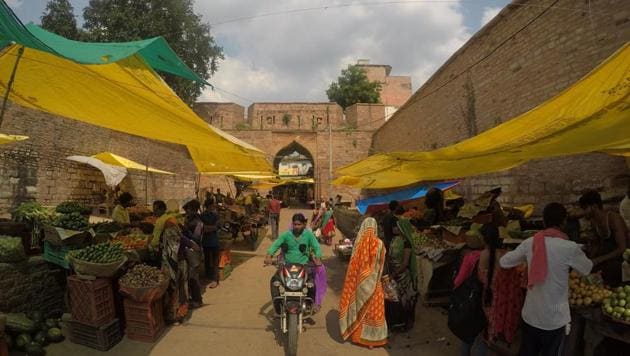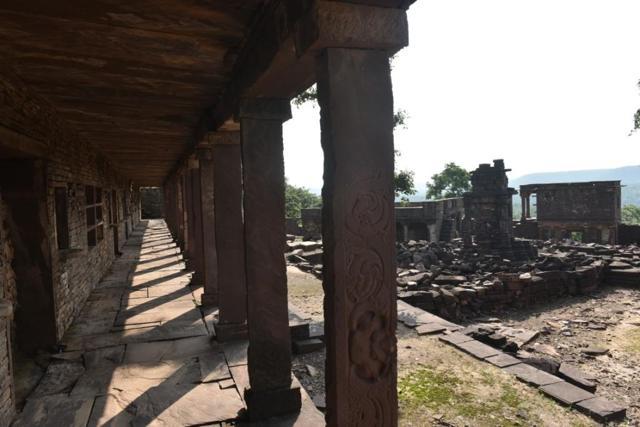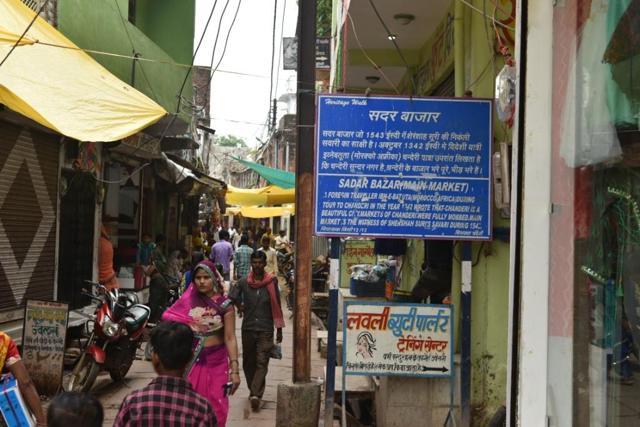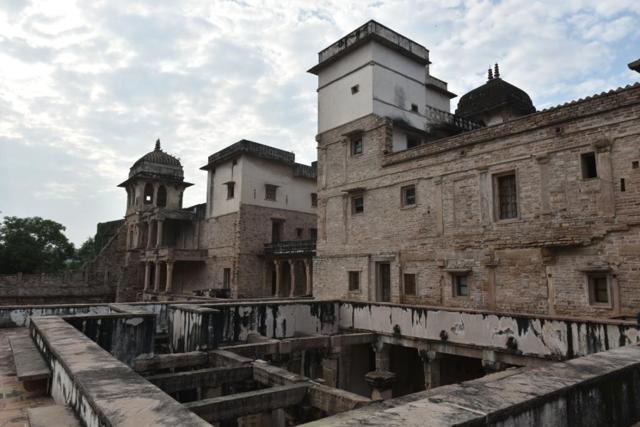Chronicling Chanderi: Handloom, heritage, and the Rajkummar Rao-Shraddha Kapoor starrer Stree – this MP town has much to boast of
The recently-released film Stree may have used Chanderi as a setting for its narrative, but the town, best known for its handloom weave, is rich in old stories – both legends and documented history
The entrance to Family Cinema, Chanderi’s new movie theatre, is up a steep flight of steps leading from a narrow by-lane, through a courtyard encircled by a cluster of houses. There are no visible ticket counters (though the shows are ticketed), stalls selling popcorn, cola or the rest of the paraphernalia associated with an urban cinema experience – just a room, air-conditioned, with approximately 100 red cushioned chairs and a giant screen in front. Its quaint but unassuming setting, though, isn’t enough to diminish the excitement of the townsfolk at this new addition to their entertainment options.

For years, the nearest movie theatre for the residents of this small town in Madhya Pradesh (MP), synonymous with the handloom weave that it produces, was in Lalitpur, a town that is a 40-minute drive away, which also boasts of the nearest railway station to Chanderi. Those lucky enough to visit Bhopal, the state capital, on business, would visit the cinema halls there. “Lakhan Talkies, opened about 60 years ago, was the first cinema hall in Chanderi. But it had to be eventually closed down. Over the years, other halls opened and closed. In 2007 I had opened a cinema hall here, but that too closed in a year. In the last 10 years, no cinema halls have been built here,” explains Rajesh Tiwari, one of the four people who got together to open Family Cinema. He gives no clear answer as to why the last few theatres had to close down.
The future of Family Cinema, however, looks bright. The opening film – the Rajkummar Rao-Shraddha Kapoor-Pankaj Tripathi starrer Stree, which has already crossed the 100 crore mark at the box office since it was released on August 31 – has a personal connect with the people of this town. Though the plot of the film is reportedly inspired by the story of ‘Nale Ba’, an urban legend of a female witch that haunted Bengaluru in the 1990s, the film has been mostly shot in Chanderi. Squeals of delight break out from the first-day-first-show audience at Family Cinema as they recognise local landmarks – “Dholiya Darwaza”, shouts one, as Rajkummar Rao jogs on screen to the tune of the quirkily-worded song “Main dil ka darzi hoon…”.“That’s the Jains’ house,” says another, pointing to the building which is Rao’s residence in the film – a house just a few steps away from Family Cinema. The front wall of the house opposite the Jains’ still bears an unblended stroke of colour used to cover the writing “O Stree kal aana”, painted on it for the shoot.
A Tale Of Two Towns
Pankaj Tripathi was not far from the truth when, in a scene in the film, he says that Chanderi is such an old town that one may even find the remains of the Harappan civilisation here. While the town was not a site of the earliest known urban culture in the Indian subcontinent, as mentioned by Tripathi, its antiquity is beyond doubt. “Prehistoric era stone tools and cave paintings have been found in and around Chanderi. Thereafter, we have found evidence of settlements in Chanderi from the Gupta era (4th - 6th century AD),” says former regional director of the Archaeological Survey of India (ASI), KK Muhammad, who was posted in MP between 2004 and 2008. The museum in Chanderi was built during his tenure.
“It is popularly believed that during the Mahabharata period Chanderi was part of the Chedi mahajanapada ruled by Shishupal, Krishna’s cousin,” says Muzaffar Ansari, or Kalle Bhai as he is better known. The best known guide in town, Ansari is also the co-convenor of the Chanderi chapter of the Indian National Trust for Art and Cultural Heritage (INTACH). Deeply respected for his knowledge of local history, Ansari’s stories about Chanderi mingle with his reminisces of his own life, so much is the town a part of who he is. “Historically, the importance of Chanderi was that it lay on the road from Delhi, connecting north and south India. Inscriptions have been found here which mention China, Babylon, Egypt, Iran, Iraq… This shows Chanderi was well known and well connected,” says Ansari.
An ASI account of the history of the town states that “at a distance of 20 km [from the present town], in Budhi (old) Chanderi which is still having archaeological remains of Jain and Hindu temples, palaces and architectural fragments dating back to 10-12th century AD. Budhi Chanderi became gradually deserted and the so-called modern Chanderi came into prominence about the middle of the 13th century AD.”

Locals believe it was the Gurjara-Pratihar king, Kirtipal, who moved the town from Budhi Chanderi to the present location in the 10-11th century AD. “Kirtipal had his capital in Budhi Chanderi,” begins Manoj Soni, former convener of the Chanderi chapter of INTACH, who also works as a guide.
Stories in Chanderi can’t be hurried. Locals take time to reflect on and reminisce, as if really going back in time to remember each tiny detail.
Soni continues: “One day Kirtipal came to what is the present town to hunt. He got separated from his companions and lost his way. After some time, he came across a pool of water, and being thirsty, drank from it. The king was afflicted with leprosy. But when he dipped his hands in the water to drink, he found his hands had healed. He bathed in the water and was completely cured. As he came out of the pool, he saw a small girl standing nearby, but she disappeared into thin air, even as he watched.” Opinion is divided about the waterbody that cured Kirtipal. While Ansari, believes it to be Parmeshwar Talaab, Soni says it was a pool near the Jageshwari Devi temple.
Legend has it, that night, Kirtipal dreamt of the girl. “She told him she was a goddess and directed him to build a temple in her honour in the place where he had seen her,” says Soni The king complied, but in his impatience he opened the door to the sanctum sanctorum before the goddess had asked him to and found only a likeness of her face inside. “Till date, only the image of her face is worshipped at the Jageshwari Devi temple,” says Soni, adding, “After this, Kirtipal moved to what is present-day Chanderi ”.
Again there are versions of the story. Manoj Choubey, or Joggi Maharaj as he is popularly known, whose family has served as priest of Jageshwari Devi temple for generations, believes that the temple has existed since the Dwapar Yug of Hindu mythology, but may have fallen into disuse over time, and Kirtipal may have simply rebuilt it.
But the most interesting aspect of this legend is, as Muhammad points out, that “there is no mention of a ruler called Kirtipal in the historical annals of the Gurjara-Pratiharas”. “He might have been a local ruler,” says Muhammad.
Living With The Past
Thick vegetation now covers much of Budhi Chanderi. Many of the inscriptions, sculptures and other historical artifacts recovered from here have been moved to the town museum. But even in the ‘new’ town, the past shares space with the present. Houses, shops and offices are interspersed with heritage monuments and old architectural remains – bawris or step wells, palaces, places of worship that are hundreds of years old but continue to be used. Busy bazaars operate around massive old gates that once served as entrances to the city – Dholiya Darwaza, Dilli Darwaza, Mughal Darwaza and others. In an arterial road, clusters of houses give way to the ruins of an old camel stable. In the backdrop are the ramparts of the old Chanderi Fort or Kirti Durg as it is better known, after Kirtipal, the king who is popularly believed to have originally built it.
“We have uninterrupted documented history of the town from about 12-13th century AD. Most of the sultans who ruled Delhi also controlled Chanderi, either directly or through their subordinates and we find mention of the town in their accounts,” says Muhammad. A board in the busy Sadar Bazar states that the great 14th century Moroccan traveller, Ibn Battuta, had, in 1342, mentioned Chanderi as a beautiful town with busy markets that were always full of people.

According to the ASI account, Chanderi was a prominent town during the reign of the Sultans of Malwa and “continued to remain an important outpost of the Mandu kingdom till the reign of Ghiyas-ud-Din Khalji, the ruler of Mandu. It was possibly one of the largest towns in Central India during the late 14th-15th century...”. “Most of the historic architecture we see in the town now is from the 15th century. It’s a rare site of the Malwa sultans,” says art historian and former member of the National Monuments Authority, Meera Dass. Also interesting, she says, is that there are traces of so many religious movements here. “There are inscriptions mentioning Sufi saints, remains of old Hindu temples and Jain sculptures and places of worship,” she says.
The town was attacked and won by Mughal emperor Babur in 1528. “There is documented evidence of weaving in Chanderi from the time of Akbar,” points out 88-year-old Kundanlal Bharatiya, a former teacher. “The Bundelkhand Rajputs captured the city in 1586 … it was annexed in 1811 by Jean Baptiste Filose for the Maratha ruler Daulat Rao Scindia of Gwalior,” reads the ASI account. In 1844, the city was transferred to the British, who lost it briefly during the revolt of 1857, but regained it in 1858. Chanderi was transferred back to the Scindias in 1861.
“Archaeologically, Chanderi is one of the richest sites of central India. It has 11 ASI-protected sites. But the protection is not adequate,” says Dass. Muhammad too believes that not enough has been done to study and document the history in and around Chanderi. As Bhopal-based, retired ASI superintending archaeologist Narayan Vyas points out, “No excavations have ever been done in the area. We have only done clearance work, which is recovering what is already available and conservation work.”
Melting In The Shadows
Ansari believes it is the lingering feel of antiquity about the town that made the team of Stree choose Chanderi for their shoot. “Bangalore is too modern,” he says.
Indeed the town is quaint, old wordly – there are only three-four functioning hotels in the town and even parts of these are still under construction or awaiting renovation. The few ATM machines are often without cash. But turn where you may, and there is some picturesque old monument or a postcard-perfect glimpse of nature – hills, water, bodies and greenery– ahead.
Obviously, a town this old and with as many heritage sites will have its own stories of spirits. Then there are the thick clusters of trees, the deep and long shadows of which have been used to such goosebump-inducing effect in Stree. “There are always stories. When we were doing the conservation of the Kirti Durg, people were talking about djinns and spirits. But I had workers living and working inside the fort and I never saw anything,” says Muhammad. The fort was the site of what is believed to have been the biggest battle in Chanderi – between Babur and Medini Rai – in 1528. “It is said that it was after this battle that the main entrance to the fort came to be called Khooni Darwaza, since the blood of the wounded and dead flowed down from the fort to the gate,” says Bharatiya. But Ansari points out that there is another local story behind the name. “Once upon a time those who were given capital punishment were thrown down from the top of the fort. The bodies would be found near the entrance and thus the name, Khooni Darwaza,” he says.
Despite the gory associations, however, it is not the darwaza, but another part of the fort that the locals believe is haunted. “During the war, many Rajput women had committed jauhar. The jauhar kund is still haunted by their spirits. People have heard screams in the night,” says Ansari. A staff member at Kila Kothi hotel, adjoining the fort, admits to having seen spirits. He exhibits no fear however at the memory. “I go my way and they go theirs,” he explains, calmly.

As in the physical space, so in the minds of the townsfolk, the screen between the past and the present is permeable. There are many stories of djinns and spirits, but they are not always willingly shared with outsiders; definitely not with one carrying a recorder. The recorder has to be switched off, interviews have to turn into conversations, before they open up. “You see, they are hesitant to share their experiences, because they can’t prove them,” explains Soni. “But even today, people here visit those who can control spirits. They may ask about a missing cow or complaint of being possessed and these people will find the cure.”
One such person is 70-year-old Kanchhedilal Bhagatji, who claims to use mantras to treat those who have been possessed. He learnt the art from his grandfather, but hasn’t taught it to any of his children. “Chanderi was a prêt bhumi (region of spirits). A lot of puja-path has been done to rid the area of spirits, but even today most houses will have a gaun or pir, who protects the family from spirits,” says Joggi Maharaj, who has a blink-and-you-miss it scene in Stree.
From individual experiences of the supernatural to sites that are collectively believed to be haunted, Chanderi has it all. Ninety-four-year-old Mohd.Ayyub claims to be able to see and converse with djinns ever since he was possessed by one. “There is one who still comes to talk to me and will do anything I ask her to,” he says with complete assurance.

A short walk away from Sadar Bazaar, where a locked shop still bears the board of Modern Tailors – the name of Rajkumar Rao’s tailoring shop in the film– one comes to Rani Mahal and Hamamkhana and Raja Mahal and Bawri, popularly known as simply Raja-Rani Mahal, one of the locations where Stree was shot. But there are reports of more than reel hauntings at the old palace. “People have heard strange sounds here, seen shadows moving. But when they went to investigate they could find nothing,” says Soni. “Some time back a young man committed suicide there. The strange thing is if you saw the tree from which his body was found hanging, you would know how impossible it is for anyone to hang himself from there. The tree is not strong enough to have supported his body,” he adds.
The old chowkidar of the palace remembers some of the strange occurrences at the site. “Once, while new lights were being fitted, the tube lit up even before the electrician had put it in the socket,” he claims.Like most old buildings in town, the palace too had basements. “These are now closed to visitors because they were so dark and scary,” says Soni. The present chowkidar points out the different parts of the palace where the Stree team had shot, but is unwilling to open up about his own experiences. It is with extreme reluctance that he finally admits: “Often I see shadows moving. But if I go, there is no one. Still, one has to investigate. It can be criminals, one never knows...” “I was a little uncomfortable initially, but now I am used to it,” he adds.
Another spot in town that is believed to be haunted is Kati Ghati – a gateway cut in the hills in 1490, by the order of the then governor of Chanderi. “But while the worker had been promised a reward it, after the gateway was completed, the governor started finding faults with it. He said that since there was no door, the security of the town had been compromised. Instead of a reward, he was given capital punishment,” says Soni.
Again, stories differ. Ansari, says the man committed suicide when he realised he had forgotten to put hinges to support a door. Locals believe his spirit haunts Kati Ghati, stopping people from crossing into Chanderi at night. Even during the day there is an eerie echo at the spot, enough to make the weak-hearted break out into goosebumps.

Then there is the old Lakhan Talkies, the first movie hall to have opened in Chanderi. “Film screenings would stop in the middle. At nights, the machines would start running on their own,” recalls Soni. Ansari, adds, “Once a part of the screen burst into flames while people were watching a film, but no one was injured.”
Not everyone is happy with the ghostly association that Stree has brought for Chanderi or the talk of djinns and spirits that the film has reignited. “Stree has turned Chanderi into a ghost town,” grumbles 77-year-old Amolak Chand as he sits chatting with Bharatiya and other old Chanderi residents. The group is divided in their opinion on the existence of spirits. While a few of them bring up some old logic-defying incident, most lean towards the opinion that spirits are nothing but imagination and the creation of a fearful mind. Even fear , though,is on the wane, feels Bharatiya. “Thirty years back the population of Chanderi was only 4,000. There were vast stretches of deserted areas. After dark, people would feel scared going from one locality to another. Now people have started living even around ruins like that of the Raja Rani Mahal; fear has lessened,” he says.
This Friday’s release at Family Cinema was the Varun Dhawan and Anushka Sharma starrer Sui Dhaaga – also a film shot in Chanderi. For a town that Ansari calls a “hidden gem” in the tourism circuit, for the few people who visit, despite its natural beauty and heritage value, the shooting of two films here, in quick succession, is way more excitement than the town has seen in years. If Stree used the town’s old-world charm to its advantage, Sui Dhaaga also references the town’s biggest industry – textiles. Both, however, seem to have captured and benefited from, the flavour of Chanderi’s fascinating small-town life.
Get Current Updates on India News, Lok Sabha Election 2024 live, Infosys Q4 Results Live, Elections 2024, Election 2024 Date along with Latest News and Top Headlines from India and around the world.




